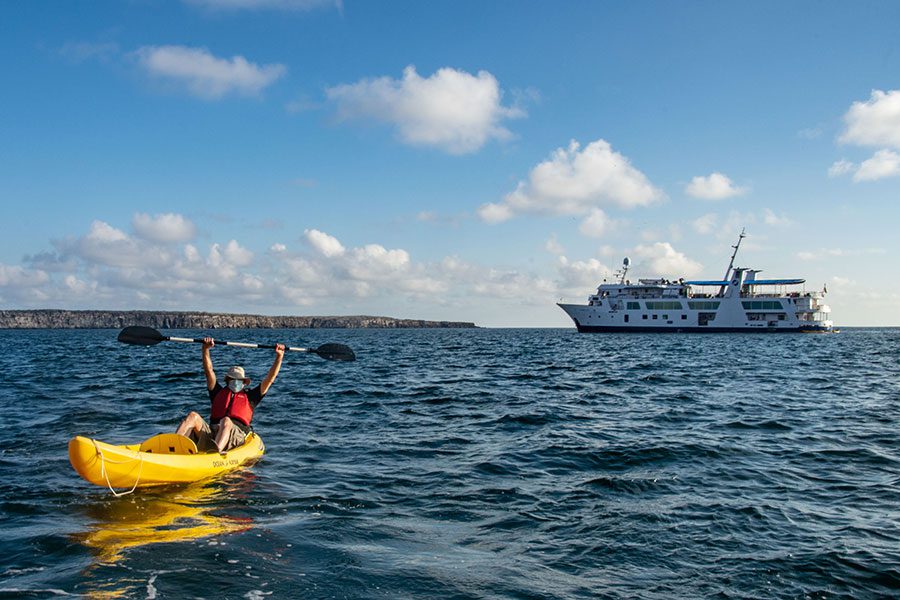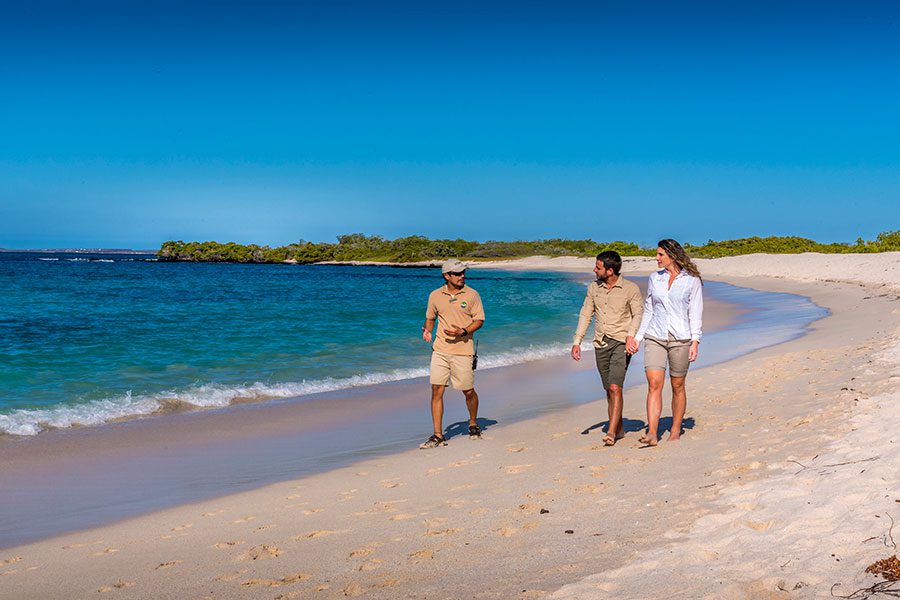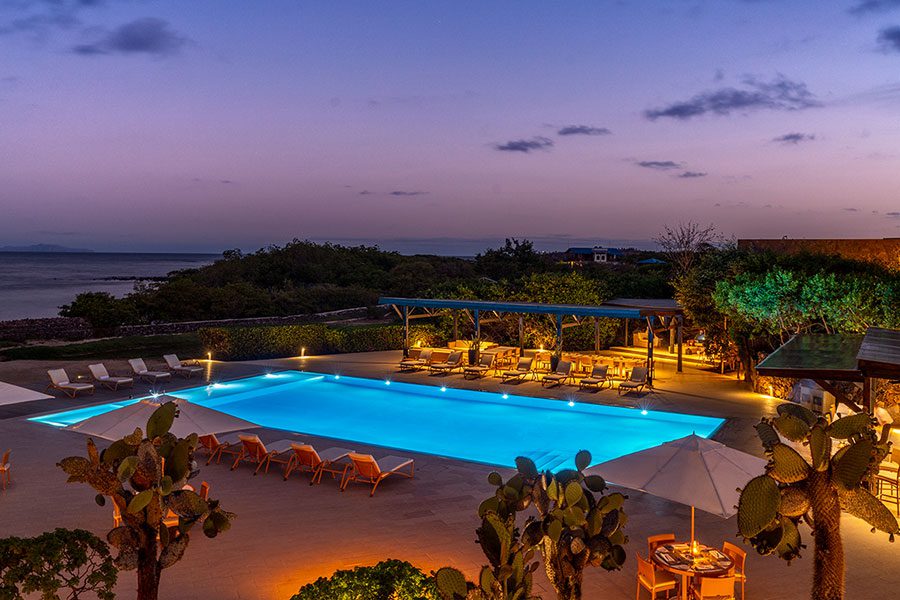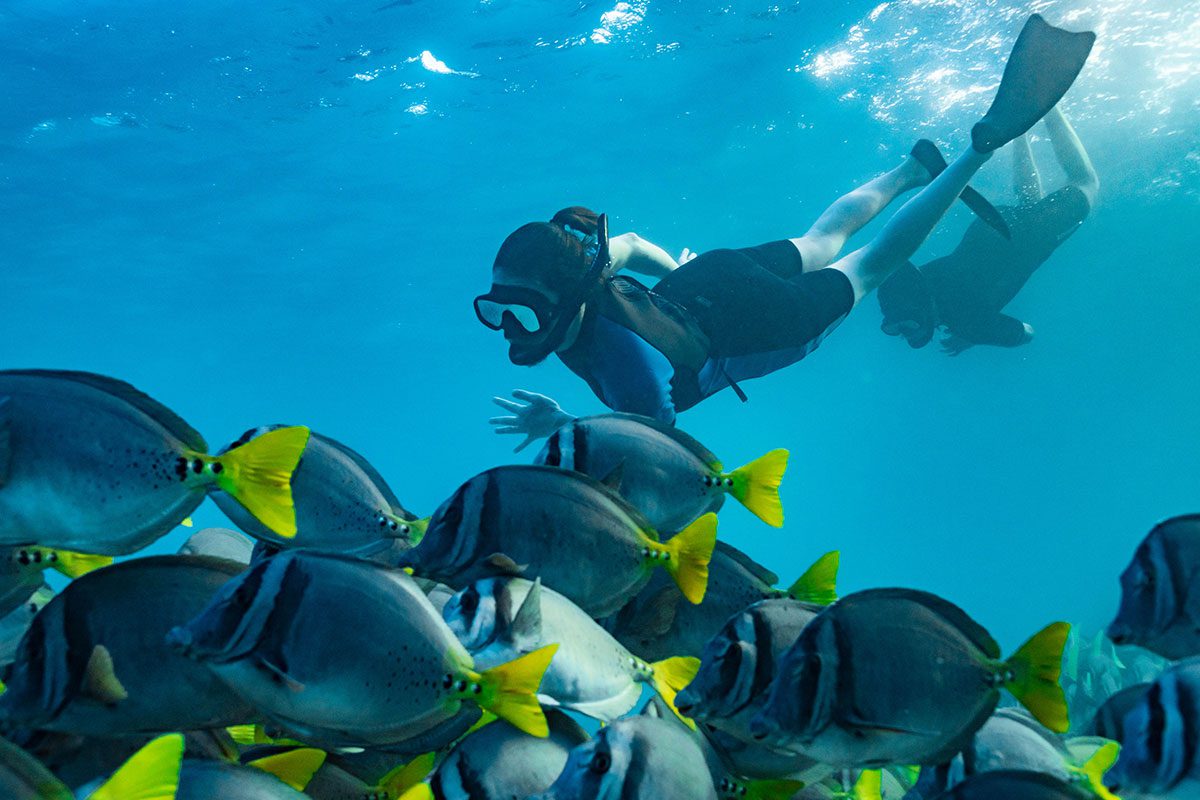“How much does it cost to visit the Galapagos?” is the first question everyone asks themselves after hearing about this one-of-a-kind destination. Related questions follow suit, like how much does a cruise to the Galapagos Islands cost? What should I look for to have the best possible Galapagos Islands trip, and how much is that worth? The answer to these and other questions will always depend on the experience you want to have on the Islands.
You may see some relatively inexpensive package offers out there. Still, you should pad your budget slightly more when it comes to having a real transformative experience in this incredible expedition destination with true peace of mind.

Javier Garcia

Eduardo Silva

Carolina Escobar
START PLANNING YOUR TRIP

Javier Garcia

Eduardo Silva

Carolina Escobar
Get in touch for more
CONTACT US
When preparing your budget for a Galapagos vacation, the first thing to consider is the tour operator you will choose for your adventure. Note that this company will make your trip worthwhile and take care of every detail so that you can focus on making the most out of your time in the Galapagos.
If you find an offer that appears too good to be true, it likely is. And, if you run into many unforeseen issues, you may find it challenging to find someone you can rely on to help you sort out any problems. Also, it can dampen your experience and be a bothersome source of stress.
In this blog, we’ll explain Galapagos tour cost options with respect to your budget while getting a glimpse of Metropolitan Touring’s fantastic way of planning an unforgettable Galapagos vacation. So, keep reading if this interests you!

What’s behind the cost of a trip to the Galapagos Islands?
Galapagos is not a cheap destination and traveling on the cheap is very much not recommended for a destination like this. The Galapagos Islands are more expensive than mainland Ecuador mainly because of their location and the logistics of fostering tourism sustainability and helping community development. That said, here are some of the reasons why travel to the Galapagos can be a bit expensive:
- There are high logistical costs for getting fresh produce and other essential items to the islands.
- Crew and staff are local to the Galapagos; salaries and wages are set according to governmental guidelines to guarantee a good living wage.
- The islands are part of the Galapagos National Park, which relies on park entrance fees (paid upon arriving in the archipelago) to fund their conservation and protection efforts. Foreign travelers pay upwards of USD 100 per person.
Note: This entrance fee will increase to USD 200 beginning in August 2024, so please keep this in mind when planning your future trip to the Galapagos.
- Activities, tours, and accommodations tend to carry higher-than-average costs because of logistics, staffing, and equipment.
Is it OK for me to visit Galapagos from a conservation standpoint?
Of course! Not only that, but this destination also has a relatively small human population tasked with the protection and conservation of a remarkable, one-of-a-kind destination teeming with incredible wildlife. Tourism is a huge component of the funding that goes into these monumental efforts. It is also the reason why the Galapagos National Park can continue doing the work they do. Travel to the “Enchanted Isles,” as they are known, is relatively easy and worthy of a place on your “must-visit” bucket list!
Galapagos Travel: How you choose to visit the islands matters!
Charles Darwin once said that the archipelago was a little world within itself, or rather, “…a satellite attached to America.” This beautiful analogy couldn’t be more accurate. The Galapagos Islands are far away from the continent, and that’s why the average cost of traveling to the Galapagos is not nearly the same as taking a cruise through the Caribbean.
It’s something to keep in mind as we answer the principal question and explain the cost of Galapagos travel and what these numbers actually mean.
The first thing you need to know is that to genuinely explore the Galapagos Islands and see the real magic happen up front, you’ll need to visit the National Park.
While you’ll be able to see some animals and visit a few visitor sites on the inhabited islands, a visit to the Galapagos is not complete if you haven’t visited its remote islands or seen some of the iconic endemic species within their very own animal kingdoms—something which is only available in the National Park.

How much does it cost to go to the Galapagos Islands?
If we keep Darwin’s analogy in mind, traveling to a place like the Moon—Earth’s natural satellite—would be costly. The first reason for the whopping cost of traveling to this rocky giant would be its location. Well, dear reader, let me tell you that a similar dynamic exists when traveling to the Galapagos Islands.
Traveling to any place as remote, isolated, and fragile as the Galapagos Islands requires infrastructure in form of transportation, accommodations, resources, fuel, supplies, equipment, staffing, and so much more. In this part, we’ll get into the details of some of these aspects.
Galapagos Cost Reason #1: Location, distance, and logistics
The archipelago is located almost 600 miles (1,000 km) off the east coast of Ecuador in the Pacific Ocean. This presents a significant distance, particularily when most of the things you need to get through your day-to-day life must be flown in from the mainland or shipped over on a cargo vessel.
Locals pay the Ecuadorian Airforce an average of USD 1.00 per 2.2 lbs (1 kg) of groceries, personal hygiene products, clothes, etc. Conversely, Galapagueños may pay other shipping companies almost USD 3.00 per 2.2 lbs (1 kg)! Ultimately, these import fees add to the average cost of any commercial goods sold in the islands.
The main reason things are flown in and not locally grown or produced on the islands themselves is to preserve the Galapagos’ fragile environment, as many non-native species could end up decimating part of the archipelago’s delicate endemic fauna.
So, as high as the costs of visiting the Galapagos may seem, imagine how expensive it is actually to live on one of the human-populated islands!
There are only four human-populated islands, and the only ones on which one can stay are: Santa Cruz, San Cristobal, Isabela, and Floreana. Flights to the Galapagos only operate between the Ecuadorian mainland cities of Quito and Guayaquil to the islands of Baltra and San Cristobal, with the former of these islands being the principal hub for the largest percentage of travelers given its proximity to Santa Cruz Island, which has the largest population of inhabitants.
Galapagos Cost Reason #2: Community and social responsibility
When you travel to the Enchanted Isles, the amount of money you spend doesn’t necessarily go directly to the tour operator’s bank account. As a matter of fact, a fair portion of this amount is immediately channeled into the local economy of the Galapagos Islands, something that significantly benefits the archipelago’s population.
The rules for guaranteeing this are straightforward: all companies or individuals wishing to operate a hotel or expedition vessel in the Galapagos must, by law, employ and hire local staff to comply with the sustainable economic development strategies of the inhabited islands.
For many, this makes perfect sense, as many locals can’t simply take a bus or commute to their job as one might on the mainland. The number of industries and employment opportunities in a destination like this is, as you can imagine, quite limited.

Galapagueños need a reliable source of income; therefore, your visit to the Galapagos Islands and your participation in the numerous activities available doesn’t just support sustainable tourism and growth—it also provides the local communities with the means to thrive and prosper.
Galapagueños are kindhearted and always willing to lend a helping hand. That’s why Metropolitan Touring takes great pride in our Galapagos National Park-certified naturalist guides, crew, expedition leaders, hotel managers, and staff. Rest assured, they will go above and beyond to provide you with the best service, along with plenty of the most enjoyable, safe, and memorable experiences available!
Galapagos Cost Reason #3: Conservation and environmental responsibility
Before the 1960s, virtually no one was interested in traveling to the Galapagos Islands. The wonders of its fearless fauna and breathtaking landscapes remained a mystery to the world until the 1970s tourism boom!
To preserve the Enchanted Isles, the Ecuadorian government created the Galapagos National Park in 1959. Approximately 97% of the islands are under the Park’s jurisdiction, while the other 3% pertains to human-populated areas like Puerto Ayora (Santa Cruz Island), Puerto Velasco Ibarra (Floreana Island), Puerto Villamil (Isabela Island), and Puerto Baquerizo Moreno (San Cristobal Island).
The Galapagos National Park (GNP) is charged with keeping things regulated and under control. Nothing slips past their radar! They monitor virtually everything that happens throughout the islands and keep track of how tourists interact with the natural wildlife and settings.
Every itinerary and exploration must be approved by the Galapagos National Park Authority and follow a specific set of rules to ensure the islands’ and visitors’ safety.
This tremendous initiative wouldn’t be possible without the help of tourism. Each time a person arrives in the Galapagos, they pay two fees: the Galapagos National Park Entrance Fee and the transit control card. Remember that entry to the Galapagos Islands is strictly regulated and controlled, even if you’re an Ecuadorian!
Here’s a quick breakdown of visitor fees:
Galapagos National Park Entrance Fees
Transit Control Card: USD 20.00
Foreign tourists over the age of twelve: USD 100.00
Foreign tourists under the age of twelve: USD 50.00
—
Nationals and legal residents of Ecuador, over the age of twelve: USD 6.00
Nationals and legal residents of Ecuador, under the age of twelve: USD 3.00
These fees may seem high, but don’t forget that they directly support the vital work necessary to preserve and protect the Galapagos’ marine and terrestrial wildlife and flora. They also support improvements to essential services for the local Galapagueño population, like education, health, sanitation, and much more!
If you’re interested in learning more about the GNP’s ongoing projects, be sure to check out their official website!
Galapagos Cost Reason #4: Having a great experience requires some investment
The Galapagos Islands are all about exploration, as each island offers you different landscapes, wildlife, and experiences. The most important thing is that you keep in mind that there’s no such thing as the “best way to experience the islands.” You have to choose the option that works best for you and fits the type of vacation you want to have.
There are two main ways to experience the Galapagos Islands: land-based tours and sea-based expeditions.
Galapagos Land-based Tour Cost
Galapagos Hotel Cost
In terms of cost, this may be a more budget-friendly option, but it comes with certain sacrifices. Hotels in the Galapagos range from USD 30.00 to USD 1000.00 per night. Booking a hotel that offers breakfast, guided activities, and tour options will always be a better and more comfortable option, especially if you want to explore the Galapagos National Park.

Transportation between islands can be arranged via a passage on chartered boats. However, some vessels are not well maintained. If the engine cuts out two hours into your voyage between Santa Cruz and Isabela Islands, a typically three- or four-hour itinerary can turn into a six- or seven-hour ordeal. Add to this the choppiness you can experience aboard a small and packed chartered vessel, and it can summon a world of seasickness.
An experienced tour operator can help you find reliable and comfortable transportation between islands, in addition to quality accommodations. That said, why not consider a place like the Finch Bay Hotel on Santa Cruz Island, which has a restaurant, bar, spa, pool, and beach. The Finch Bay’s privileged location is beautifully isolated yet still quite close to Puerto Ayora. The hotel has an on-site expedition leader that can help you plan activities, including exciting day tours to nearby islands in the GNP aboard the hotel’s very own Sea Lion Yacht.
Well-planned Day Tours will often conclude in the afternoons, as the Galapagos National Park does not authorize visits to its protected areas during nighttime.
We strongly recommend a land-based tour if you want a more relaxed vacation involving your preferred activities and plenty of time to relax by the pool with your beverage of choice and one-of-a-kind service.
If you’re considering this type of option, make sure you talk to one of our destination experts for the best insights with respect to your Galapagos land-based trip.
Galapagos Cruise-based Tour Cost
Imagine yourself waking up to a new landscape every morning or feeling the wind caress your face as you witness the exact moment when the sun (and all its magnificent shades of orange) melts into the ocean. As poetic as this may seem, it is not an uncommon experience when you travel aboard an expedition vessel.
Galapagos Islands cruise price explained
If you want to have an excellent and in-depth experience of the islands and make the most out of your time in the Galapagos, then an expedition cruise may very well be the perfect option for you. Here’s the breakdown of the reasons:
1. You’ll save plenty of transportation time
Believe it or not, the Galapagos Islands encompass over a very large area. It may not seem like it, but if you calculate the distance between each island, the miles just keep adding up! Traveling from one visitor site to another takes time, so anything shorter than a 5-day itinerary is just not worth it. Why? Well…
Picture this: You book a 4-day cruise, arrive in the Galapagos, board your vessel, get settled in, and half of your first day is gone. Similarly, your departure day can take up the whole day, given the early-morning checkouts and transfers to the airport! This means you’ll only have just about two and a half days to explore and interact with the islands. Your entire tour might just feel rushed and supremely underwhelming!
However, if you choose an itinerary that offers you five or more days, you’ll get to travel further and genuinely enjoy the islands without the much-dreaded fear of missing out and/or feeling incredibly rushed.
These options may be more expensive, but they often include meals, activities, and airport transfers. Consequently, they’re a worthwhile option that should be seen an investment in your satisfaction and a fulfilling experience of the islands rather than an expense!
For many, the Galapagos Islands are a once-in-a-lifetime trip. Traveling to this remote location can be pricey, but if you’ve already decided to embark on this adventure, you might as well get the most out of it!
Some expedition vessels not only offer greater area coverage but a greater variety of experiences, too. Take our ships, for example: Our fleet offers multi-guided expeditions, meaning you’ll get to experience the islands at your own pace and preference. If hiking isn’t your thing, maybe try your hand at snorkeling or even take a ride aboard a magnificent glass-bottom boat. Whatever you choose to do, our guides will always make sure every group has a great time experiencing the islands.
Also, guests can learn new and exciting things through daily lectures offered by naturalist guides. There’s also plenty of time at leisure to relax in one of our ample social areas.
2. You’ll see the Galapagos’ main attractions: unique landscapes and endemic species
In terms of cost, this aspect is something you’ll probably want to consider. You need to keep in mind that each island is like a world unto itself: varied wildlife, landscapes, and ecosystems.
Let’s take red-footed boobies, for example. This magnificent species can be found at Punta Pitt on San Cristobal Island and Darwin Bay on Genovesa Island. While San Cristobal is closer to the central islands and easier to reach, keep in mind that making it all the way up to Genovesa to see this species could also be very much worthwhile.
On this island, you’ll find the largest colony of red-footed boobies in the entire archipelago! Also, these birds seem freer, more fearless, and more bold due to the island’s secluded location and complete absence of human presence. It truly is a fantastic thing to observe if you’re lucky enough!
Given the fact that not all ships reach Genovesa Island (located in the northeastern archipelago region), an itinerary that includes this island may have a different price. The operational cost (food, maintenance, and fuel) of traveling a greater distance could be higher, and you’ll need a bigger vessel to sail slightly choppier seas calmly.
If you want to do more research on what to see or where to travel in the Galapagos Islands, make sure you check out our Galapagos Big 15 of iconic species, our ranking of the top islands to visit in the archipelago, and how to choose the best itinerary!
Why do Galapagos’ travel costs vary so much?
When it comes to Galapagos expedition vessels, you get what you pay for. It’s as simple as that. You can find options ranging from USD 1,200 per guest for a 5-day/4-night itinerary all the way to USD 6,000 (or more) per passenger for a similar itinerary.
Nevertheless, when choosing the best expedition vessel, the price isn’t the only thing you should consider. Keep in mind that the best option is the one that fits and caters to your preferences and helps you get the most out of your time in the archipelago, regardless of the price.
Altogether, a great vessel can be the x-factor that turns your “pretty good” vacation into an excellent and unforgettable one. Traveling aboard an expedition vessel is a more time-efficient way of enjoying your Galapagos journey, too! While you catch up on sleep, the ship quietly sails from one island to the next! Also, you don’t need to go back to a land-based hotel after each excursion; instead, you can go further and take advantage of every minute!
Should I pick the cheaper option?
“Incredible deals” can end up being, well, not so great. That said, if you’re willing to make some sacrifices in terms of comfort, safety, privacy, and experience, then sure, an “incredible deal” could be the way to go. However, let’s break it down just so you can see what we mean.
A lower price may imply a smaller boat with a skeleton crew and around 16 passengers. This doesn’t sound so terrible, right? You might even think that it will give you a more “intimate” experience of the islands. In this case, “intimate” can quickly turn out to mean tight quarters, shared bathrooms, few or no menu options, and zero privacy.
The size of your vessel matters: Don’t confuse intimate with cramped
Imagine sharing a boat measuring just about 88 feet (28 meters) in length with 16 other people! Typically, traveling aboard a vessel of this size for several days on end can feel rather cramped. Not only will your room feel like a matchbox, but the boat’s social areas won’t be as comfortable as they should be.
This lack of space will also mean that your cabin will be very close to sea level, where the not-so-quiet engine is situated. In addition to these problems, you need to consider that smaller vessels tend to rock more in open waters due to their reduced stability! So, all in all, you may feel squished, sleepless, and possibly even seasick. That sure sounds like one hell of a vacation!
Now, if you think that comfort doesn’t need to be one of your top priorities in a destination that’s supposed to be adventurous, then you might be in for a nasty surprise.
Enjoy activities at your own pace aboard multi-guided vessels
A smaller vessel usually comes with just one naturalist guide, which means you’ll be bound to a single activity at each site during your visit to the islands! Remember that the Enchanted Isles are a National Park after all, and one of its most important rules is that a guide must always accompany visitors. So, unfortunately, if you would prefer to snorkel instead of hike, that won’t be an option aboard a smaller vessel.
Compare this to a more comfortable expedition vessel with multiple certified guides, where groups are smaller, and you have different options available.
Another vital thing to note is that the archipelago has a maximum number of visitors per site. If you travel aboard a small vessel, you’ll most likely find four other groups at the same location, which can feel a little crowded and noisy. Also, you won’t have as wide a range of activities like kayaking, paddleboarding, and glass-bottom boat rides since a smaller boat typically has no space to transport all this equipment.

So, should I pick the most expensive Galapagos Cruise option?
The most expensive expedition vessels won’t be uncomfortable or cramped, but you may find yourself surrounded by many things you don’t really need and yet are paying good money for. Features like onboard pools, butlers, and balconies may seem significant on paper, but do you really need them?
Don’t forget: the Galapagos Islands are an expedition destination. This means that, as you make your way through the archipelago, you’ll disembark on a new island daily to go on a new adventure. Unlike a Caribbean cruise, you won’t spend every minute of your day aboard the boat! And who needs a small pool when you can swim in one of the world’s most beautiful oceans?
Luxury cruises in the Galapagos Islands shouldn’t focus on trivial aspects like butlers or piano bars; instead, they should aim to help you get the most out of your time on the islands. A vibrant experience should have a well-balanced itinerary, breathtaking visitor sites, an abundance of wildlife, and magnificent spaces to relax before, between, and after your daily excursions.
How should I book my Galapagos trip?
Now that you’ve read about the options and are excited to travel to the Galapagos Islands, you must make sure you book your trip the right way.
You can contact your local travel agency or try buying directly from an Ecuadorian tour operator in terms of booking options. We recommend you try these options before booking through websites. After all, there’s nothing more reassuring than talking to a travel expert that will tell you what exactly you are paying for.
TALK TO A DESTINATION EXPERT

Diego Zapata

Rosa Mena

Sandy Lara

Diego Zapata

Rosa Mena

Sandy Lara
Wrapping Up: The True Cost of Traveling to the Galapagos Islands
When you’re thinking about a destination to visit, the first thought that comes to mind is not necessarily the price. Instead, your first thought should be imagining yourself there. Try it! You can almost hear the sandy shores sifting under your shoes or the warm embrace of sunlight on your skin. You can feel yourself traversing across an otherworldly path that leads you to an exciting place that you’re bound to fall in love with.
You’re thinking of all the beautiful sensations, sunsets, food, activities, and accommodations. You’re not just paying for a cabin or a room; you’re paying for the whole experience, memories, and emotions you’ll get out of your trip. This is what the cost of traveling to the Galapagos should truly include.
Have the Galapagos Islands intrigued you? Check out our Galapagos Information.


